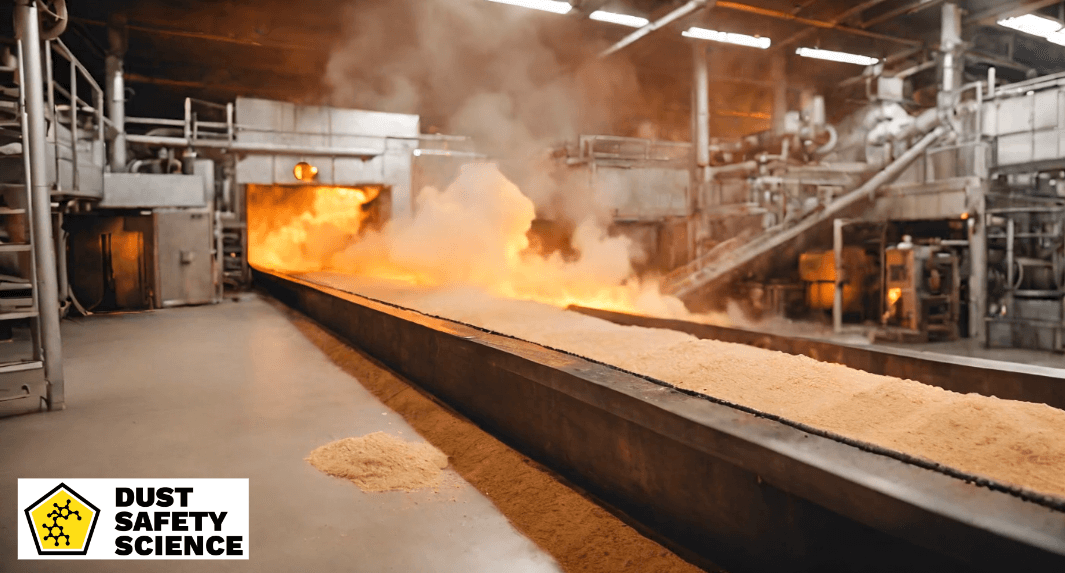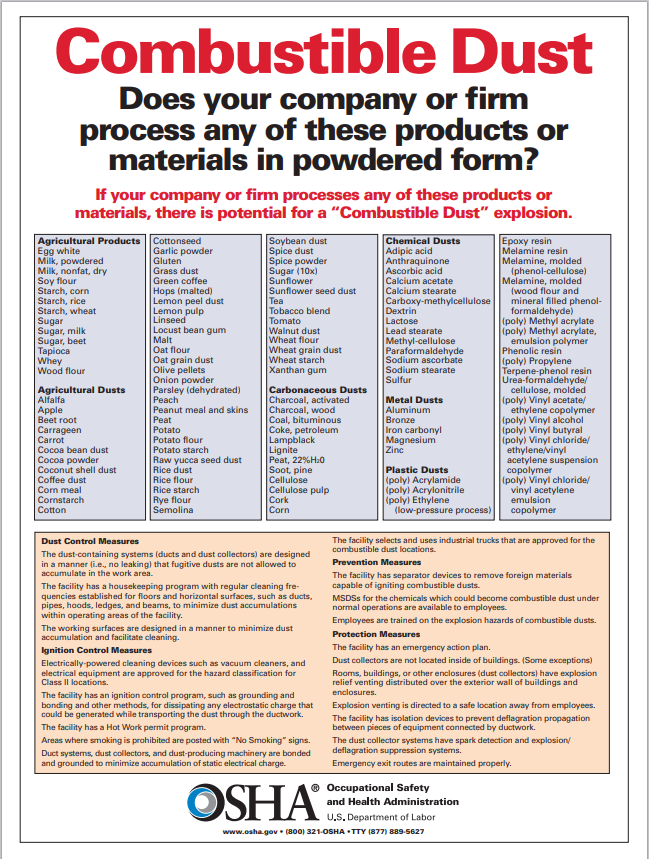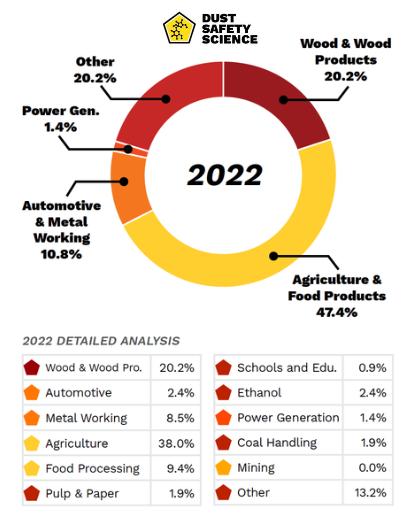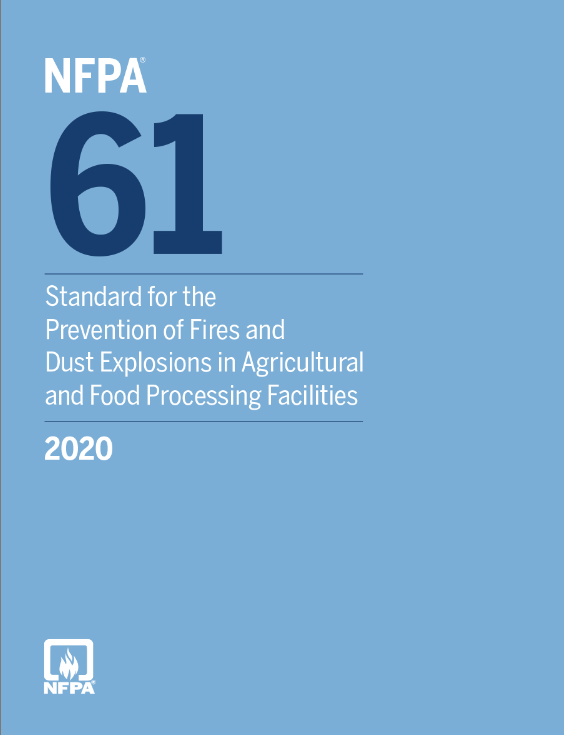Updated September 17, 2024 Authored by Dr. Chris Cloney and Jon Barrett of Dust Safety Science
 A picture of a Combustible Dust Explosion and Combustible Dust, in a Food Processing Facility, on a Conveyor Belt
A picture of a Combustible Dust Explosion and Combustible Dust, in a Food Processing Facility, on a Conveyor Belt
Key Takeaways:
- Industry Dynamics: The food processing industry, encompassing various operations such as milling, grinding, drying, and packaging, handles a wide range of organic materials that can generate combustible dust particles, in extremely fine, small particle size, creating explosion hazards and possibly cause a dust explosion. This industry sector faces unique challenges due to the diverse nature of food products, raw materials, and dry goods processed, including grains, sugars, spices, and powdered additives. The handling and processing of these materials create conditions conducive to the accumulation of dusts, in a dust collector, and airborne dust, presenting significant explosion hazards if not managed properly.
- Hazards of Combustible Dust: Combustible dusts in the food industry poses serious risks due to its potential for a dust explosion hazard or fire. Fine dust particles generated during processing operations can become suspended in the air, forming explosive mixtures when combined with oxygen. Ignition sources such as sparks, static electricity, hot surfaces, or open flames can trigger rapid combustion, leading to a devastating fire and explosions that endanger workers, damage equipment, and disrupt operations.
- Specific Concerns: The food industry and processing plants often handle bulk quantities of ingredients and dry goods, such as flour, sugar, starch, and spices, which are prone to generating dusts. Operations involving milling, grinding, mixing, and blending can produce fine particles that accumulate on surfaces, inside ventilation systems, clogging a dust collector, and on structural components and equipment, increasing the risk of dust explosions. Drying and dehydration processes are common in the food sector for preserving perishable products or creating powdered ingredients. However, these food sector processes release significant amounts of dust particles, small in particle size.
The Specific Food Processing Equipment, Combustible Dust Generation, and Root Causes
In process industries and processing plants, common raw materials and sources of dust include flour, sugar, cocoa powder, and various other food powders and particles. The Occupational Safety and Health Administration, (OSHA), identifies Food Ingredients as Combustible Dust. Fine particles generated during various stages of processing, such as grinding, pulverizing, blending, and mixing, constitute the primary source of dust in these facilities. Combustible dust is considered to be a solid material that is composed of distinct particles, regardless of their shape, size, or chemical composition. The production of food requires the transportation, storage, and processing of a wide range of raw ingredients as combustible materials. The food sector is vital for delivering safe and consumable products to our tables.
The hazards and explosion risk posed by combustible dust in the food sector and processing plants have been a cause for concern, leading to numerous dust explosion incidents that demand our attention and analysis. Dust is an ever-present danger in various industries, including processing and food manufacturers. The dust consists of fine dust particles and particle size that, when suspended in the air in the right concentration, can ignite and cause a combustible dust explosion or fire. Common processing materials like flour, sugar, spices, and starches can become combustible, with the proper explosion parameters, when dispersed in the atmosphere under certain conditions, such as inadequate ventilation or improper housekeeping. A catastrophic dust explosion involves five elements: fuel or dust sufficiently small to burn when ignited rapidly, an ignition source, oxygen, dispersion or suspension in the air, and confinement. These five elements are often referred to as the “Dust Explosion Pentagon.
Dust is a serious food processing hazard that can lead to catastrophic dust explosion incidents if not properly managed. To mitigate the fire and explosion risks associated with dust, various standards and regulations have been put in place. In the year 1923, was when the National Fire Protection Association, NFPA, published the first standard on dust, as no national regulations were enacted to address the problem of dust directly, and dust-related explosions and fires, along with loss of life and property, continued to occur. Some NFPA standards listed are the important dust standards, safety guidelines, and regulations, to prevent dust fires and dust explosions, and why they are crucial for the safety of workers and the prevention of dust explosion disasters in the food sector:
- NFPA 61, Standard for the Prevention of Fires and Dust Explosions in Agricultural and Food Processing NFPA 61 protects lives and property from fires and dust explosions in facilities handling, processing, or storing bulk agricultural materials, their by-products, or other agricultural-related dust and materials.
- NFPA 68, Standard on Explosion Protection by Deflagration Venting applies to the design, location, installation, maintenance, and use of devices and systems that vent the combustion gases and pressures resulting from a deflagration within an enclosure so that structural and mechanical damage is minimized. Chapter 8 of the NFPA 68 provides guidance on Venting of Deflagrations of Dusts and Hybrid Mixtures, Effects of Vent Ducts, Bins, Hoppers, and Silos, Venting of Dust Collectors Using Bags, Filters, or Cartridges, Bucket Elevators, Venting Internal to Building with Flame-Arresting and Particulate Retention Device, Venting Silos or Other Storage Vessel Provided with Integral Bin Vents, and Deflagration Venting of Enclosures Interconnected with Pipelines.
- NFPA 654 Standard for the Prevention of Fire and Dust Explosions from the Manufacturing, Processing, and Handling of Combustible Particulate Solids. The NFPA 654 Standard is referenced by OSHA’s Combustible Dust National Emphasis Program (NEP) to identify hazards and define mitigation strategies that help protect life and property from a fire and explosion. The standard provides industry-recognized safety practices for facility and systems design, inspecting a dust collector and dust collection systems, inspecting electrical equipment from dust, process equipment protection. In addition, this standard provides guidance on how to prevent dust explosions with fugitive dust control and housekeeping, refrain from the use of compressed air when cleaning, preventing dust clouds, ignition source identification and control, fire protection, training and procedures, inspection, and maintenance. Annexes offer guidance on the application of area electrical classification and hazard identification for various dust accumulation levels.
The hazards associated with dusts in grain handling facilities and process industries are not to be underestimated. When ignited, the explosive potential of these particles can wreak havoc, leading to devastating consequences for both human lives and property. In the food sector and processing, seemingly harmless substances—sugar, flour, spices, starch, and even dried milk or grain particle, have the potential to form dust and cause a dust explosion. A dust collector and dust collection systems must be maintained and inspected regularly, as well as inspecting rotary valve issues. A preventive measure for dust explosions is to install an active system detects pressure changes and injects chemical flame suppressants, typically sodium bicarbonate, into the dust collector, to prevent the flame front. Here is a list of common processing equipment often found in processing that can be associated with explosive dust:
Grinders and Pulverizers: Used for reducing food ingredients into fine particles, these machines can generate more dust from substances like spices, grains, or nuts.
Mixers and Blenders: Equipment utilized to blend different ingredients can create dust, especially when handling powdered substances like flour or powdered flavorings.
Dryers and Evaporators: These appliances are used to remove moisture from food products, and during this process, they can generate dust from dried food materials.
Conveyors and Elevators: Transport systems used in food processing plants may agitate or transport fine particles, leading to dust dispersion.
Packaging Equipment: Machinery involved in packaging powdered food products can also contribute to dust buildup.
Milling and Sifting Machines: These machines can generate dust when refining or separating food materials like grains or sugar.
As a result of the processing equipment and chemical engineering of food products, creating dust, a dust collection system may accumulate dust and have ignition sources to cause a dust explosion. Comprehensive risk management in processing facilities involves understanding the equipment and processes contributing to combustible dust hazards. Implementing a combination of preventive measures, stringent protocols, and ongoing vigilance can significantly mitigate the risks, and explosion severity associated with combustible dusts, while preventing a dust cloud, and prevent a dust explosion, and combustible dust incidents.

Examples of Specific Foods and Ingredients, Creating Combustible Dust Generation
Combustible dust is a significant hazard in various industries, particularly in processing and manufacturing. Understanding the generation and impact of dust from specific food and ingredient types is crucial for ensuring workplace safety and preventing potential accidents. Here are some food and ingredient types that contribute to examples of dust generation:
Almond Dust, Animal Feed Processing, Barley Dust, Chile Dust, Cocoa Dust, Coffee Dust, Dehydrated Alfalfa, Dried Egg Yolk, Dried Herbs, Dried Rice, Fish Meal, Flour Dust, Grain Dust, Ground-Up Pet Food, Malt Dust, Milk Powder, Nut Dust, Overdried Pulp, Peanut Dust, Potato Dust, Powdered Milk, Rice Dust, and Sugar Dust.
Understanding the specific food and ingredient types that contribute to dust generation is crucial for implementing effective preventive measures, including proper ventilation, inspecting dust collection systems and bag filters, housekeeping protocols, and employee training on safety practices. Mitigating the cross contamination risks associated with dust and dust layer, is vital to ensure a safe working environment in food processing and manufacturing industries.

A picture of a detailed analysis and percentages of several Industries, including Food Processing, affected by Combustible Dust, from Dust Safety Science
Historic Food Industry Related Combustible Dust Explosions
Between 1980 and 2012, the U.S. Chemical Safety Board investigated more than 280 dust incidents that killed 141 people and injured 767 others. Food manufacturing plants are among the most susceptible to these incidents, especially those in the baking segment that use a lot of flour and sugar, creating more dust around electrical equipment. Combustible dust incidents, continue to occur worldwide and in the food sector as presented in this combustible dust research and incident database from Dust Safety Science. In addition, statistics of the most prevalent industries, regarding dust incidents, are also captured in this Annual Incident Report Database, from Dust Safety Science. During 2022, Food Processing dust occurred in 9.4% of dust incidents. In addition, the Dust Safety Science Podcast educates the public on Reconciling Hygiene with Explosion Safety in Food Industries with Dr. Chris Bloore. Some of the historic food sector dust explosions and incidents include:
- Giacomelli’s Bakery Warehouse (1795): According to ScienceDirect, the 1st recorded combustible dust explosion, occurred at an Italian flour mill, when flour dust came in contact with a mounted lamp, which injured two workers. A local man named Count Morozzo examined the results of the explosion and wrote a report giving the probable cause of the explosion as the dry flour dust. Source: Dust explosion causation, prevention and mitigation: An overview
- The Douglas Starch Works Plant Explosion of 1919: The Douglas Starch Works company produced cooking starch and oil, laundry starch, soap, and animal feed. A massive explosion rocked the building, which was located on First Street SW, just off of C Street SW. The walls collapsed, pieces of the factory were hurled up to two miles away, and smoke billowed in the evening sky. Joseph Hubbell, manager of the National Inspection Company of Chicago, commented on the disaster in an issue of the National Underwriter. It was his opinion that the explosion occurred in the plant’s wet process buildings, where some dry starch may have built up. Source: The History of Douglas & Company
- The Imperial Sugar Refinery Explosion (2008): In February 2008, the Imperial Sugar Refinery in Port Wentworth, Georgia, suffered a massive explosion triggered by combustible sugar dust. The explosion claimed the lives of 14 workers and injured dozens more. The refinery was heavily damaged, and nearby communities were affected by the blast. Investigations revealed inadequate housekeeping practices and a lack of proper dust explosion prevention measures. This incident prompted regulatory changes and increased awareness of the dangers of dust in industrial settings.
The history of dust explosions in the food sector spans centuries, with incidents ranging from the earliest recorded explosion at Giacomelli’s Bakery Warehouse in 1795 to more recent tragedies like the Imperial Sugar Refinery Explosion of 2008. These incidents, separated by time but linked by a common thread of neglecting safety measures, underscore the inherent risks associated with the accumulation of dust in industrial settings. Giacomelli’s Bakery Warehouse marked the inaugural entry in the annals of dust explosions, as flour dust ignited upon contact with a mounted lamp, injuring workers and illuminating the hazards posed by seemingly innocuous materials. Subsequent events, such as the Douglas Starch Works Plant Explosion of 1919, further underscored the catastrophic consequences of inadequate safety protocols. This major incident emphasized the importance of proper ventilation, explosion venting, inspection of dust collectors and explosion protection systems, good housekeeping, and ignition source control to mitigate the risk of a dust cloud, and dust explosions.

A picture of the NFPA 61 Guide and the NFPA 61 Standard for the Prevention of Fires and Dust Explosions in Agricultural and Food Processing Facilities
Conclusion
Despite advancements in safety regulations and technology, incidents of dust explosions persist, as evidenced by the ongoing documentation provided by Dust Safety Science’s combustible dust research and incident database. This comprehensive resource not only catalogs past tragedies but also sheds light on the prevalence of such incidents in various industries, and the safety and health, risk factors. According to Dust Safety Science’s Annual Incident Report Database, food processing dust accounted for 9.4% of dust incidents in 2022, underscoring the continued need for proactive measures to address hazards and loss prevention within the food processing and food manufacturers sector and beyond, to prevent combustible dust incidents.
In light of the statistics and historical context, it is evident that combating dust requires a multifaceted approach that prioritizes ongoing education, rigorous safety protocols, dust control, identify ignition sources, and industry-wide collaboration. The lessons gleaned from past tragedies, such as the Giacomelli’s Bakery Warehouse explosion in 1795 and the Imperial Sugar Refinery explosion in 2008, underscore the importance of vigilance and adherence to safety standards and process safety. By leveraging resources like Dust Safety Science’s databases, stakeholders in the food industry, grain handling, and beyond can gain valuable insights into risk factors, loss prevention trends, and best practices for mitigating a dust cloud and dust hazards.
About Dust Safety Science
For more from Dr. Chris Cloney on Combustible Dust in the Food Industry, visit this podcast episode: Reconciling Hygiene with Explosion Safety in Food Industries with Dr. Chris Bloore.

Resources:
Visit Dust Safety Science (Global Incident Tracking)
Visit Dust Safety Academy (Resources, Training, and Events)
Visit Dust Safety Professionals (Need Help? Get Support Today!)
Visit Dust Safety Journal for the Complimentary, Dust Safety Science Monthly Journal
Subscribe to our Complimentary, Dust Safety Science Newsletter at Dust Safety Science Newsletter
Visit the Dust Safety Science blog for written articles on combustible dust safety including the latest research, expert opinions, and state-of-the-art in fire and explosion protection.
